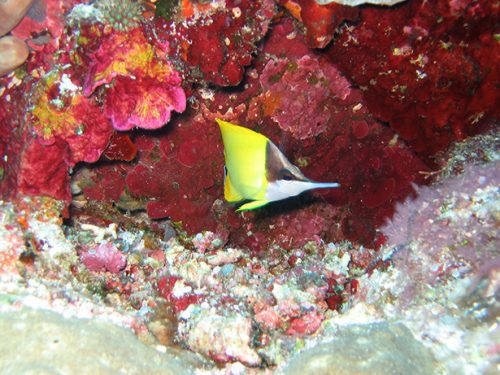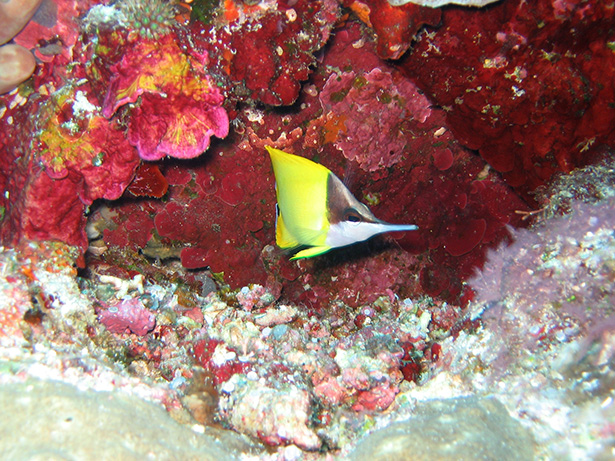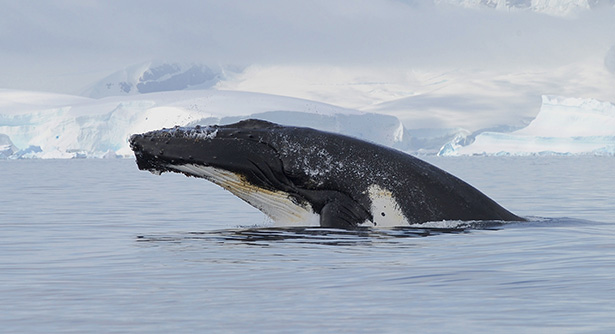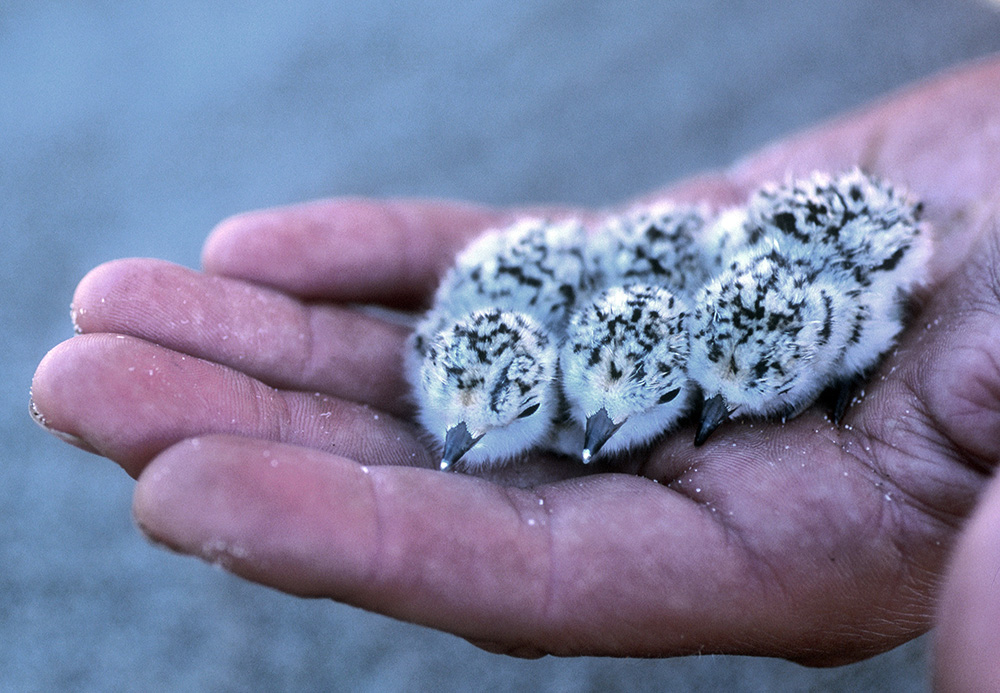
 |
|
Longnose butterflyfish in a coral reef off the Philippine Islands. Photo Dwayne Meadows, NOAA.
|
In 1994, when astronomer Carl Sagan called our home planet a “pale blue dot,” he described the essence of our fragility. Viewed from Voyager 1, millions of miles away, our entire existence is reduced to a single speck.
“To me,” Sagan wrote, “it underscores our responsibility to deal more kindly with one another, and to preserve and cherish the pale blue dot, the only home we’ve ever known.”
Humans need to cherish planet Earth, including its oceans. Take, for example, a story from marine ecologist Mark Hixon, professor emeritus at Oregon State University and currently a professor at University of Hawai‘i at Mānoa, who has studied coral reef systems since 1979. Hixon writes about the death of his favorite coral reef in a 2009 compilation of stories on climate change.
“This kaleidoscopic potpourri of millions of species, born of millions of years of evolution, was no match for the accelerating rate at which modern humans have been warming the global climate with ceaseless carbon emissions,” he writes.
That death was part of a warming event in 1998 that killed nearly 10 percent of all coral reefs on Earth.
Our planet’s oceans are vast but not inexhaustible, Hixon tells EW, and scientists are learning how ocean life is threatened by the onslaught of rising sea levels, warming temperatures and a chemical change in ocean waters called ocean acidification.
Casualties of Climate
“There’s a concern that wildlife isn’t going to have a place to live as habitat gets inundated by sea level rise,” Shaye Wolf tells EW over the phone from San Francisco. In 2013, Wolf, climate science director with the Center for Biological Diversity, compiled a report that found rising tides threaten 233 federally protected species under the Endangered Species Act (ESA).
Many animals impacted are those that depend on the beach for survival, such as loggerhead sea turtles that use Florida beaches to lay their eggs, or Hawaiian monk seals that give birth on islands and other dry land.
Wolf says in her report that sea levels are expected to rise up to 6.5 feet by 2100, a result of melting ice due to warming temperatures. As ocean waters swallow beaches, a barrier of oceanfront hotels, houses and businesses cuts off access to habitat beyond those beaches. Species are trapped in the middle.
“Many coastal areas in the U.S. are heavily developed, leading to coastal squeeze,” Wolf explains.
In Oregon, the western snowy plover, a shorebird, is feeling that squeeze. According to Wolf’s report, snowy plovers were protected under the ESA in 1993 — plovers were abandoning their nests, surrounded by too much human activity. Wolf says almost half of snowy plover beach habitat is below 6 feet. By the year 2100, plovers might have half as many areas to reproduce and nest.
 |
|
A humpback whale swims in Antarctic waters. Photo courtesy Ari Friedlaender, collected under NMFS and ACA permits
|
Melt Down
In the Antarctic Ocean, where Ari Friedlaender of OSU’s Marine Mammal Institute studies minke whales, climate change is altering the marine landscape in a different way.
Minke whales are the smallest of the baleen whales, Friedlaender says, although at 35 feet long, they’re still pretty big. Even so, they’re small enough to maneuver through sea ice in the Antarctic, hunting for food in places where larger whales can’t fit.
“Minke whales need sea ice for protection from predation and feeding purposes,” Friedlaender says. When the ice melts from rising temperatures, minke whales have to share their hunting grounds with larger humpback whales, and they risk getting eaten by predators, such as orca.
This may sound like a good deal for humpbacks, but in the long term, Friedlaender says, it affects them negatively, too. A primary food source for baleen whales and other marine life in the Antarctic is krill, a tiny crustacean that thrives when pack ice is high. As sea ice diminishes, so does the amount of Antarctic krill.
“These animals are evolved to take advantage of the substrate that’s generally been there for them for thousands and thousands of years, but they can’t change their biology fast enough,” Friedlaender says. “Conditions have changed in an accelerated way, and we’ve contributed to that. It’s unfair.”
Acid Burn
“We’ve had this vision of the vastness and inexhaustibility of the oceans, that the oceans are so huge that there’s no way we can make them change,” Hixon says. “It’s probably been imbedded in the human psyche since the dawn of time. In the last century, we’ve completely proven that assumption to be wrong.”
The tropical coral reef ecosystems Hixon studies are impacted by human activity in a multitude of ways, from overfishing to invasive species, but Hixon says on a global scale, a chemical change in ocean water is also taking its toll on marine life, particularly for species like coral that use a mineral called calcium carbonate to build their skeletons.
In its most simple terms, ocean acidification is a basic chemistry equation. The ocean absorbs carbon dioxide from the atmosphere — as the amount of carbon dioxide in the air goes up from burning fossil fuels, so does the amount the ocean absorbs.
Carbon dioxide mixes with seawater to form carbonic acid, the guilty party in soda pop that dissolves our teeth, Hixon says. The ocean’s acidity has grown by 30 percent since the beginning of the Industrial Revolution, according to the National Oceanic and Atmospheric Administration.
For Oregon’s shellfish, including oysters, this makes it difficult for mollusk larvae to form their shells, leading to oyster die-offs at local shellfish farms.
For corals, long-term exposure to carbonic acid means that their skeletons corrode away.
“As a coral-reef scientist, I feel like a caregiver at a cancer hospice,” Hixon writes in his 2009 essay.
 |
|
Baby western snowy plovers. Photo courtesy BLM
|
One Ocean
Just as it’s difficult to conceptualize the immensity of the oceans, it’s also challenging to confront a problem as global and pervasive as climate change. Wolf suggests appealing to higher powers.
“I think the key message here is that there’s clear and really disturbing evidence that climate change is harming ocean life,” she says, “and the U.S. and the Obama administration need to make serious cuts to greenhouse-gas pollution to prevent further harm to the ocean life we all depend on.”
Protecting natural coastal systems, including coral reefs and marshes, will also play a role in saving these species, she says.
Hixon says that now more than ever, it’s important for scientists to continue studying marine ecosystems and documenting the forces that change them.
“A lot of people don’t imagine the ocean as particularly relevant to them, but oceans are responsible for half the oxygen that’s produced in the world,” Hixon says. “Coral reefs in particular are becoming a new source of anticancer drugs, and who hasn’t been touched by cancer? The oceans are important to everyone.”
For more on ocean acidification and its impacts on marine life, head to Corvallis’ Science Pub 6 pm Monday, May 11, at Old World Deli, 341 2nd St., with OSU Professor George Waldbusser.